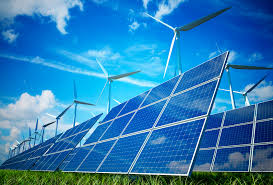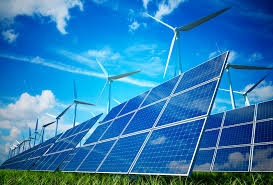
The International Energy Agency says that a transition of energy consumption habit is underway as renewable energy accounted for almost half of all new power plants in 2014.
Green energy is set to overtake the dirtiest fossil fuel in the early 2030s, even as it is now the second-largest generator of electricity in the world, after coal, said the IEA's World Energy Outlook 2015 Report.
“The biggest story is in the case of renewables,” said IEA executive director, Fatih Birol.
“It is no longer a niche. Renewable energy has become a mainstream fuel, as of now.” He said 60% of all new investment was going into renewables but warned that the $490bn of fossil fuel subsidies in 2014 meant there was not a “fair competition,” he said.
The global agency claimed that there would be a dramatic slowdown in the growth of carbon emissions due to the rapid rise of renewables charted in the new IEA report. However the agency still believes that the world was set to see an increase of 2.7 degree C in average temperature which would be significantly more than the 2 degree C considered to be the threshold of dangerous warming.
“A major course correction is still required,” said the report.
“World leaders meeting in Paris must set a clear direction for the accelerated transformation of the global energy sector,” said Birol.
“The difference between 2.7 degree C and 2 degree C is not something meaning you can take your jacket off and adapt to life - it will have major implications for all of us,” he added.
This rapid rise in renewable energy would also bring in troubled times for coal.
“Coal has increased its share of the global energy mix from 23% in 2000 to 29% today, but the momentum behind coal’s surge is ebbing away and the fuel faces a reversal of fortune,” says the report. The IEA projects a 15% share by 2040.
Developments in China have been the major factor in coal’s decline.
“The era of the China boom in terms of energy demand growth is coming to an end. This is a major story and has implications for the entire world,” said Birol.
While China had the biggest energy efficiency program in the world, it is also the one that is the championing the cause of renewable, the report states. A major nuclear program for power and likely growth in unconventional gas has also brought in woes for coal, the report noted.
However this decline in demand for coal would be offset by a nearly tripled demand for coal in India by 2040, IEA says.
“South-east Asia is amazingly important and not getting much attention. It is the only region in the world where the coal demand is increasing its share,” said Birol.
In the absence of climate policies, cheap coal and renewables would squeeze out gas in the region, he said.
“India is moving to the centre stage of energy,” said Birol. By 2040 global coal consumption and oil demand would be driven by India even as the country would account for 20% of the globe’s solar power installations, says IEA.
“The choices India makes will be important for all of us, and therefore there is a need for supporting India’s push for clean and efficient technologies,” he added.
(Source:www.theguardian.com)
Green energy is set to overtake the dirtiest fossil fuel in the early 2030s, even as it is now the second-largest generator of electricity in the world, after coal, said the IEA's World Energy Outlook 2015 Report.
“The biggest story is in the case of renewables,” said IEA executive director, Fatih Birol.
“It is no longer a niche. Renewable energy has become a mainstream fuel, as of now.” He said 60% of all new investment was going into renewables but warned that the $490bn of fossil fuel subsidies in 2014 meant there was not a “fair competition,” he said.
The global agency claimed that there would be a dramatic slowdown in the growth of carbon emissions due to the rapid rise of renewables charted in the new IEA report. However the agency still believes that the world was set to see an increase of 2.7 degree C in average temperature which would be significantly more than the 2 degree C considered to be the threshold of dangerous warming.
“A major course correction is still required,” said the report.
“World leaders meeting in Paris must set a clear direction for the accelerated transformation of the global energy sector,” said Birol.
“The difference between 2.7 degree C and 2 degree C is not something meaning you can take your jacket off and adapt to life - it will have major implications for all of us,” he added.
This rapid rise in renewable energy would also bring in troubled times for coal.
“Coal has increased its share of the global energy mix from 23% in 2000 to 29% today, but the momentum behind coal’s surge is ebbing away and the fuel faces a reversal of fortune,” says the report. The IEA projects a 15% share by 2040.
Developments in China have been the major factor in coal’s decline.
“The era of the China boom in terms of energy demand growth is coming to an end. This is a major story and has implications for the entire world,” said Birol.
While China had the biggest energy efficiency program in the world, it is also the one that is the championing the cause of renewable, the report states. A major nuclear program for power and likely growth in unconventional gas has also brought in woes for coal, the report noted.
However this decline in demand for coal would be offset by a nearly tripled demand for coal in India by 2040, IEA says.
“South-east Asia is amazingly important and not getting much attention. It is the only region in the world where the coal demand is increasing its share,” said Birol.
In the absence of climate policies, cheap coal and renewables would squeeze out gas in the region, he said.
“India is moving to the centre stage of energy,” said Birol. By 2040 global coal consumption and oil demand would be driven by India even as the country would account for 20% of the globe’s solar power installations, says IEA.
“The choices India makes will be important for all of us, and therefore there is a need for supporting India’s push for clean and efficient technologies,” he added.
(Source:www.theguardian.com)





